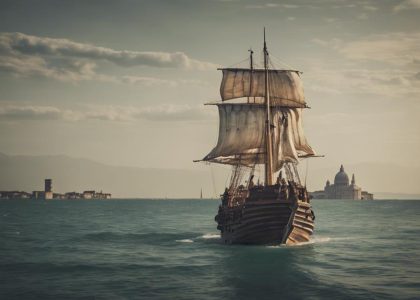In the midst of Pisa's rich historical tapestry lies a maritime legacy that has endured the test of time. The preservation of this seafaring history not only encapsulates the essence of the city's past but also serves as a crucial link to understanding its cultural evolution. As we delve into the methods employed to safeguard this maritime heritage in 2024, a multifaceted approach becomes apparent, intertwining traditional conservation techniques with innovative digital initiatives. However, the real question that looms ahead is whether these efforts will be sufficient to secure Pisa's maritime history for generations to come.
Historical Significance of Pisan Maritime Legacy

The historical significance of Pisan maritime legacy is deeply rooted in the city's rich naval traditions and strategic importance in Mediterranean trade routes. Pisa, a prominent maritime power during the Middle Ages, established itself as a key player in Mediterranean commerce through its advanced shipbuilding techniques and navigational expertise. The city's naval prowess enabled it to expand its influence across the region, engaging in trade with diverse cultures and fostering economic growth.
Pisa's maritime heritage is exemplified by its iconic Piazza dei Miracoli, where the renowned Leaning Tower stands as a testament to the city's maritime achievements. The Pisans' mastery of maritime technology and navigation not only facilitated trade but also contributed to the cultural exchange and dissemination of knowledge throughout the Mediterranean world.
Today, as efforts are made to preserve and promote Pisa's maritime history, it is crucial to recognize the enduring legacy of the city's naval traditions and their impact on shaping the region's history. By safeguarding this heritage, future generations can continue to appreciate and learn from Pisa's maritime legacy, ensuring that its significance endures for years to come.
Conservation Efforts in Pisa

Efforts are underway to safeguard and preserve the maritime heritage of Pisa through dedicated conservation initiatives. The rich history and cultural significance of Pisa's maritime legacy are being actively protected through various preservation efforts. To evoke emotion in those who value freedom, consider the following:
- Community Involvement: Local residents are coming together to volunteer their time and resources to ensure that Pisa's maritime history is passed down to future generations. The sense of unity and shared purpose is palpable, driving the conservation efforts forward.
- Environmental Sustainability: Conservation initiatives in Pisa prioritize sustainability, aiming to protect not only the historical sites but also the surrounding natural environment. This commitment to eco-conscious practices resonates with individuals who value the freedom to enjoy a clean and healthy planet.
- Educational Outreach: Schools and cultural institutions are actively involved in raising awareness about the importance of preserving Pisa's maritime history. By educating the younger generation, a sense of responsibility and freedom to cherish and protect their heritage is instilled.
Digital Preservation Initiatives

Preserving Pisa's maritime heritage now extends into the digital realm with the implementation of innovative preservation initiatives. In an era where technology plays a vital role in safeguarding historical legacies, Pisa has embraced digital preservation strategies to ensure the longevity of its maritime history. By digitizing documents, artifacts, and records related to Pisan seafaring traditions, the city is not only protecting its past but also making it more accessible to a global audience.
To provide a clearer picture of the digital preservation initiatives in place, the following table outlines some key strategies and their benefits:
| Initiative | Description |
|---|---|
| Digitization of Archives | Scanning and storing historical documents electronically for easy retrieval and conservation. |
| Virtual Reality Tours | Creating immersive experiences for virtual visitors to explore Pisan maritime history in a dynamic way. |
| Online Exhibitions | Showcasing maritime artifacts and stories through virtual galleries accessible to anyone with an internet connection. |
These initiatives not only preserve Pisa's maritime heritage but also ensure that future generations can engage with and appreciate the city's rich nautical past.
Educational Programs for Heritage Awareness

Implementing educational programs is key to fostering heritage awareness in preserving Pisa's maritime history. By engaging individuals of all ages in learning about the rich maritime heritage of Pisa, we can ensure that this valuable history is not forgotten but instead cherished and passed down to future generations. To evoke emotion and create a sense of urgency in preserving this heritage, consider the following:
- Interactive Workshops: Hands-on activities that allow participants to experience maritime traditions firsthand can instill a deep appreciation for the history and cultural significance of Pisa's maritime heritage.
- Historical Reenactments: Bringing the past to life through reenactments of significant maritime events can evoke a sense of pride and connection to the city's seafaring roots.
- Storytelling Sessions: Sharing personal anecdotes and historical tales related to Pisa's maritime history can create a sense of empathy and belonging, encouraging individuals to become stewards of this valuable heritage.
Future Prospects for Maritime Preservation

Moving forward, the advancement of technology holds promise for the sustained preservation of Pisa's maritime history. Embracing innovative techniques such as 3D scanning, virtual reality, and digital archives can revolutionize how we document and protect the maritime heritage of Pisa for future generations. By harnessing these technological tools, we can create detailed digital replicas of historical ships, waterfronts, and artifacts, ensuring their conservation even in the face of natural disasters or deterioration.
Furthermore, the integration of artificial intelligence and machine learning algorithms can aid in the identification, categorization, and restoration of maritime relics, streamlining the preservation process and enhancing our understanding of Pisa's seafaring past. Collaborations with tech companies and research institutions can facilitate the development of specialized software tailored to the unique challenges of maritime preservation, making it more efficient and cost-effective.
As we look ahead, the synergy between technology and maritime preservation presents a wealth of opportunities to safeguard Pisa's rich nautical legacy, empowering us to protect, explore, and celebrate this vital aspect of our cultural heritage.





